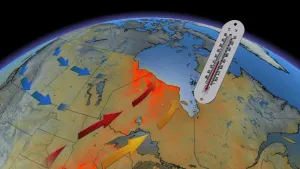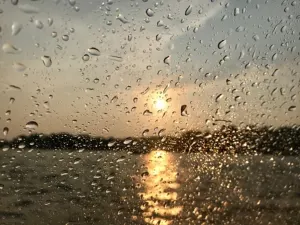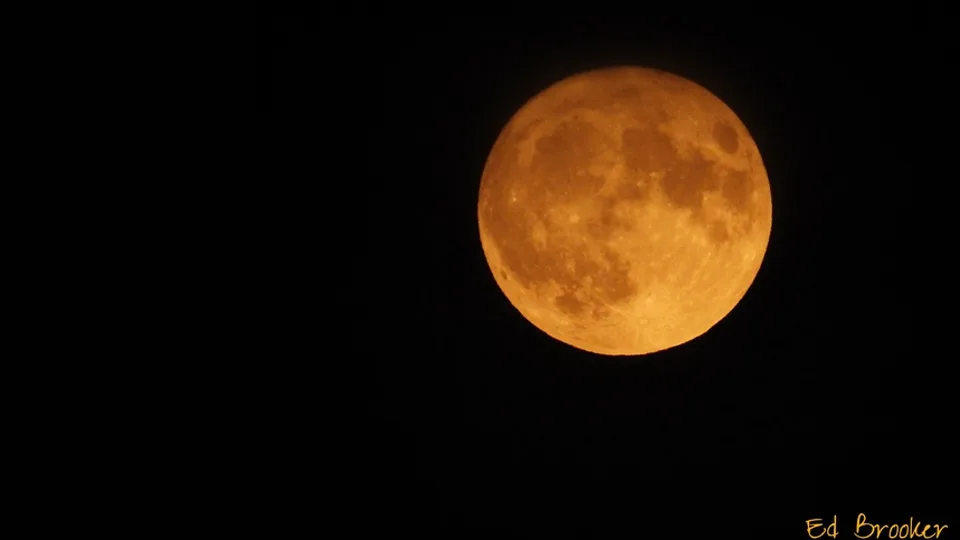
Four fun facts about Thursday night's Full Strawberry Moon
This final supermoon of 2021 is also the first of four Full Moons we see this summer!
Have some free time and clear skies Thursday night? Head outside and look up to see the first of four summer Full Moons — the Super Strawberry Moon.
The Full Moon will be up from sunset to sunrise on Thursday night. To see if you'll have clear skies, be sure to check your local forecast on our the website or on our app.
Read more: Why is the supermoon so compelling to us?
WHAT IS A 'STRAWBERRY' MOON?
The Old Farmer's Almanac says that each Full Moon of the year goes by several names. In June, we see the Full Strawberry Moon. They say it also goes by names such as Berries Ripen Moon, Birth Moon, Blooming Moon, Egg Laying Moon, Hatching Moon, Green Corn Moon, Hot Moon, and Hoer Moon.
As for why June's Full Moon is called the Strawberry Moon, the Almanac says: "This was the time to gather ripening strawberries in what is now the northeastern United States."
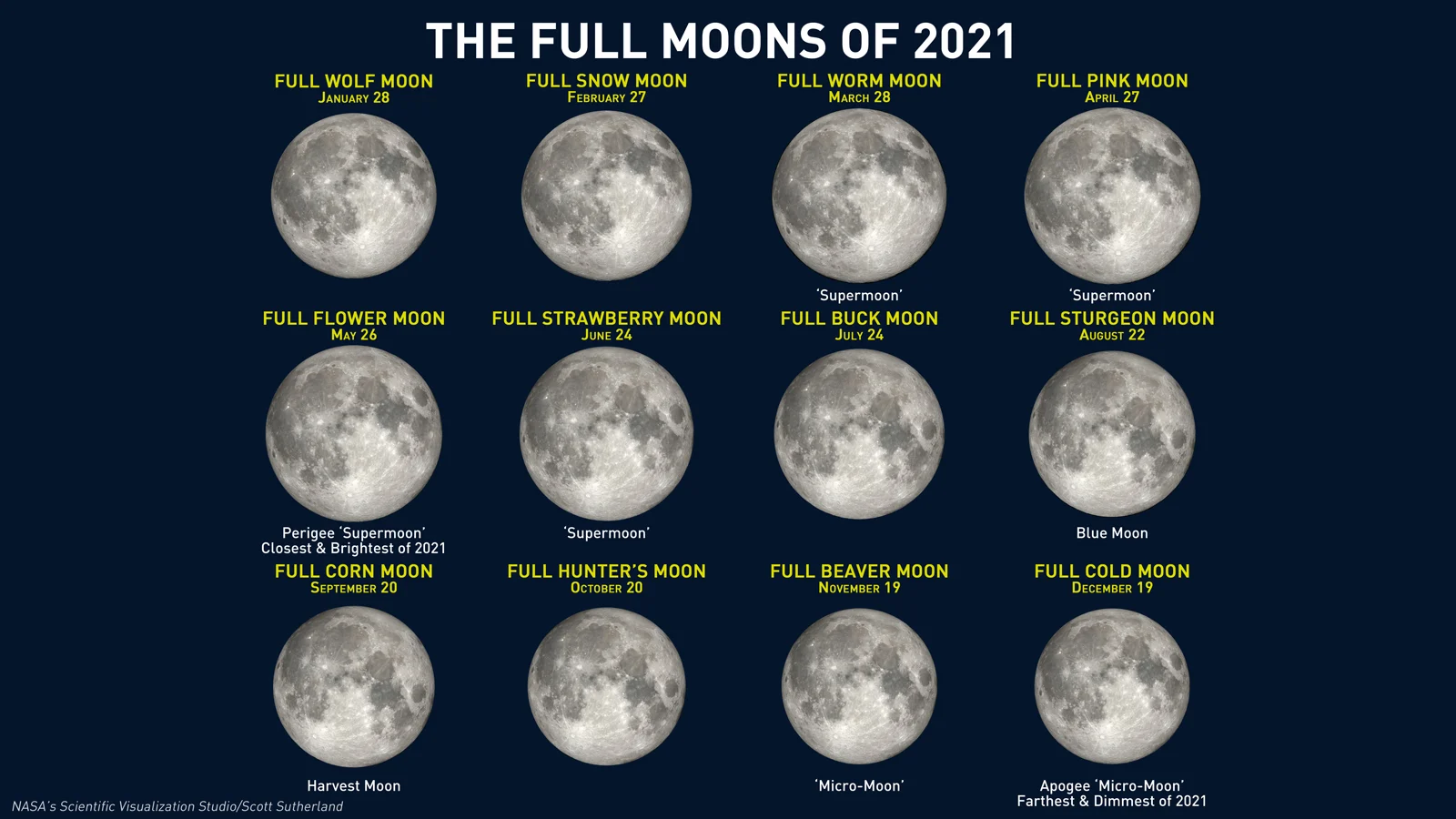
This graphic collects all the relevant data about each Full Moon of 2021, including their popular names, whether they are a 'super' or 'micro' Moon, a perigee or apogee Full Moon, and whether they are remarkable in some other way (Blue Moon or Harvest Moon). Credit: NASA's Scientific Visualization Studio/Scott Sutherland
These Full Moon names are simplifications or very loose translations of terms and phrases taken from various First Nations peoples. According to Western Washington University's Spanel Planetarium, many indigenous peoples had names for the June Full Moon.
The name Strawberry Moon comes from the Anishnaabe (Chippewa and Ojibwe) in the Great Lakes area and the Sioux in the Great Plains. The Creek, Lakota, Haida, and Shawnee peoples also referred to it regarding the ripening of berries, blackberries or raspberries.
Others, such as the Abenaki, Algonquin, Cherokee, Hopi, Kalapuya, and Mohawk, gave the June Full Moon names based on the planting or ripening of crops, such as corn or camas. The Assiniboine, Cree, and Pueblo named it based on the timing of leaves reaching their full size or deepest green. Some based their names on animals, such as the buffalo (the Arapaho and Omaha), the turtle (Potawatomi) and the crane (Choctaw). The Passamaquoddy, Ponca, and Shoshone people named it after the season or the start of the year's hottest weather.
RELATED: SEE EVERY VIEW OF THE MOON FOR 2021 IN LESS THAN 5 MINUTES
SUPER MOON OR NOT??
Depending on who you ask or how closely you want to track these things, the June 24 Full Moon is the last of four supermoons for 2021, or it is just another average Full Moon, not worthy of the "super" moniker.
A supermoon is a Full Moon that is at or closer than 361,524 km from Earth. Based on that, if you take the Full Moon to happen at precisely one specific time (as you'll see in many astronomy guides), of the dozen Full Moons of 2021, only those in April and May are precisely timed to occur when the Moon is that close. On April 27, the Moon was full at exactly 11:33 p.m. ET, and at that time, it was 357,637 km away. On May 26, the Full Moon happened at 7:14 a.m. ET, and at that time, it was 357,453 km away. It was also smack dab in the middle of Earth's shadow, resulting in a total lunar eclipse!
In March, it was close. At the exact timing of the Full Moon — 2:50 p.m. ET on the 28th — the Moon was 362,153 km away. However, it closed the distance into 'supermoon range' at around 10 p.m. ET that same night.
The June Full Moon will be slightly late. The Full Moon occurs at exactly 2:40 p.m. ET on the 24th, at a distance of 361,594 km. That's just 70 km shy of being within supermoon distance, and it will have slipped beyond that distance just 25 minutes before.
So, if we go by what's written above, then yes, the Full Strawberry Moon is just a typical, non-super Full Moon.
However, according to NASA, the June 24 Full Moon will reach 100 per cent full, starting sometime just before noon EDT. At that time, it will be both full and within supermoon distance (361,312 km). It remains in supermoon distance until 2:15 p.m. ET, and it will still be 100 per cent full until just after 5 p.m. ET.
So, those of us in Canada won't see Thursday night's Full Moon rise as a supermoon. Still, someone will see a Super Strawberry Moon for at least a couple of hours on Thursday. That's close enough that we can still count this as the fourth and final supermoon for 2021.
FOUR FULL MOONS?
With each of our four seasons lasting roughly 3 months and typically one Full Moon per month, you could expect there to always be three Full Moons each season. However, our astronomical seasons don't line up perfectly with our calendar months. For example, Summer began on June 20, and it ends on September 22. So, technically, the overlap of a week or so at the start means that the season spans over 4 months. Thus if their timing is just right, you can see four Full Moons in one season.
It just so happens that 2021 is one of those years where this occurs. This first Full Moon of Summer is on June 24. Then, the following three Full Moons are on July 24, August 22, and September 20.
With four Full Moons this season, that means the third of those — on August 22 — is a Blue Moon. In this case, it's the Blue Sturgeon Moon (or 'Blue Corn Moon' if you follow some indigenous Moon lore).
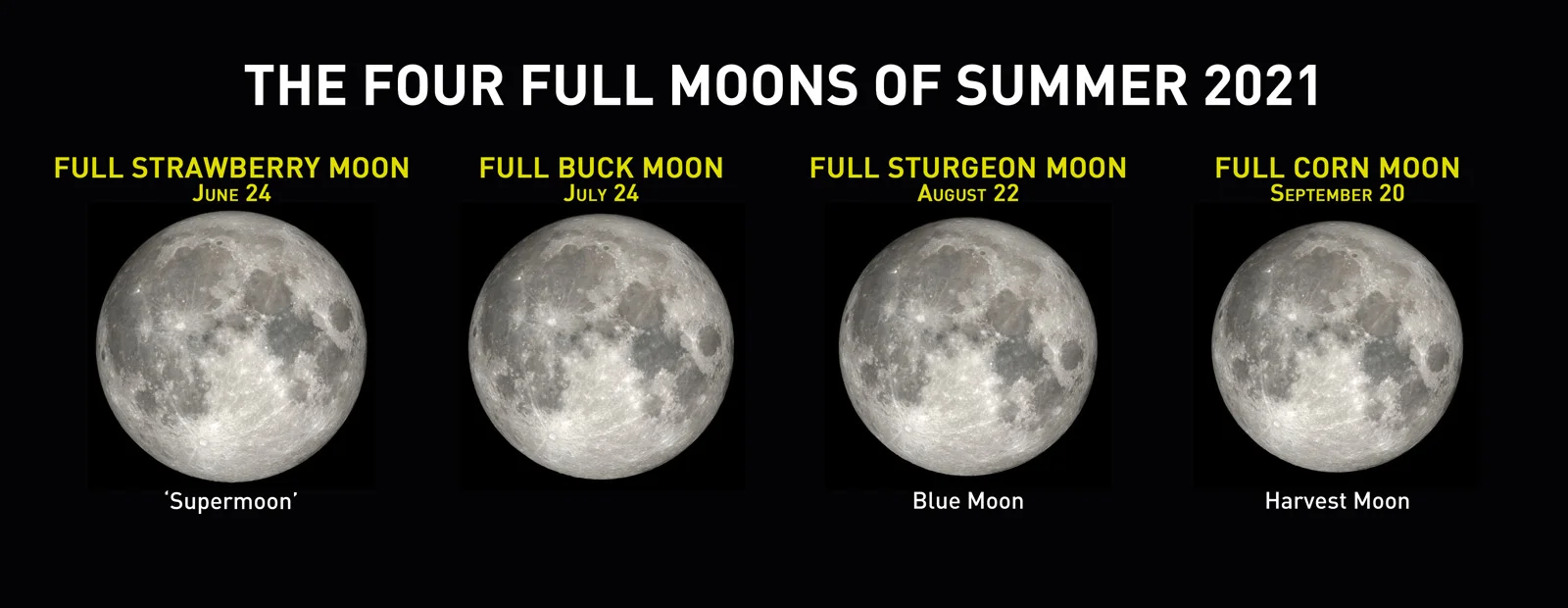
The four Full Moons of 2021. Credit: NASA's Scientific Visualization Studio/Scott Sutherland
A 'seasonal Blue Moon' occurs every few years. The last one was on May 18, 2019, when we saw four Full Moons in the spring of that year. The next seasonal Blue Moon, after this year, will be on August 19, 2024, when we will again see a summer with four Full Moons.
There's another kind of Blue Moon, by the way. Although it's not the original definition of Blue Moon, these days, we also apply that title to the second of two Full Moons that occur within the same calendar month. The last time we saw one of these was in October of 2020. The next time will be in August of 2023.
THE MADDENING MOON ILLUSION
Seeing the Full Moon at any time of night is a spectacular sight. However, go out just after moonrise or just before moonset for what is usually an exceptional treat. It's not something the Moon itself is doing, though. It's due to a little trick of our mind known as The Moon Illusion.
There are times when the Moon actually does look bigger to us, such as during a supermoon, when the Moon is physically thousands of kilometres closer to Earth than usual. There are other times, however, when we just think it looks larger.
As our eyes take in the world around us, our brain knows from experience that objects close to us tend to appear larger and in focus. In contrast, distant objects tend to be tiny and blurry. From this, it also knows that for a distant object to appear in focus, it must be very large.

This close-up of the Harvest Moon was snapped in Calgary, AB, on September 13, 2019. Credit: Siv Heang
So, when we see a bright Full Moon hanging crisp and clear in the sky above the horizon, it is contrasted by all of the objects on the ground, which appear smaller and blurrier the closer they are to the horizon. This combination confuses the brain. To compensate, the brain interprets the Full Moon as being much bigger than it truly is. To be clear, the Moon is certainly much larger than any of the objects on the horizon (it's 3,474 km across), but this 'illusion' gives us the impression that the Moon looks enormous!
Look up into the sky closer to the middle of the night, and the Moon will be high above our heads. Usually, it will be the only thing we see, other than the stars and maybe a few planets. At that time, the brain is focused only on the Moon, and without the other objects in the field of view to complicate matters, it is free to just 'see' its actual size.
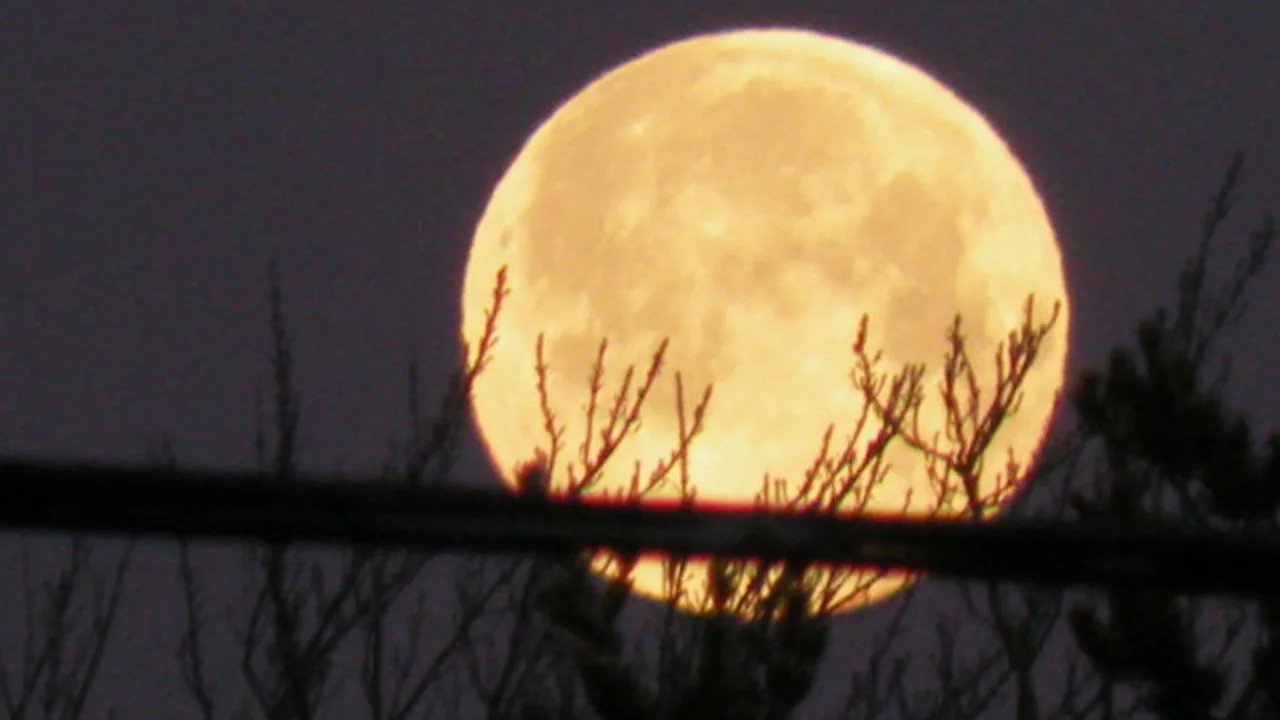
This zoomed-in image of the Full Snow Moon was captured from Salisbury, NB, on February 9, 2020, and uploaded into the Weather Network's UGC gallery. Credit: Darlene MacLeod/Smith
We have a few tricks of our own that can cancel out the Moon illusion, though.
For the first one, we don't need technology. Just go outside after sunset and find the Moon near the horizon. Stretch your arm out towards it, and cover the Moon over with your thumb or even your pinky finger. Note how big the Moon looks compared to the digit in question, and keep that in mind. Maybe even take a picture of it, if you want. Later in the night, check out the Moon again when it is high in the sky. It may appear smaller than when you saw it earlier, but repeat the step to cover it over with your thumb or finger. Compare it with what you saw before, and you'll find that the Moon is actually precisely the same size at both times.
There is a way technology can help us, though. When the Moon is low on the horizon, take out your cellphone, turn your camera on, and point it at the Moon. Note: it is possible for the Moon illusion to still work on us when looking at a picture or video. This is because the brain will make the same judgments of distance, blurriness, and size it did when looking at a 'live' scene. Still, directly comparing what we see in the sky at that time to what is shown on our small cellphone screen can help put things into better perspective. Plus, you can also take a few pictures to upload into the Weather Network UGC Gallery while you're at it!







